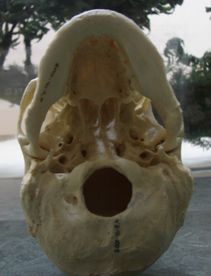|
Go to site main page, student resources page. |
File last modified:
Go to Essay 3, Introduction, Essay 5, |
This text was drafted by award-winning MMW TAs Tara Carter and Beth Peterson, (Anthropology) in the summer of 2008, supported by the MMW-based research funds left in his account on the death of Prof. Donald F. Tuzin, long an instructor and supporter of MMW. The text was substantially modified by Professor David K. Jordan in summer, 2011 to fit it to the needs of MMW-11.
This text may be freely reproduced for non-commercial educational purposes.

How the skull sits on top of the vertebral column is one of the best indicators of an organism’s locomotor pattern, that is whether or not it is bipedal. The vertebral column fits into a hole in the bottom of the skull called the foramen magnum (definition). In modern Homo sapiens, the foramen magnum is positioned in the center of the bottom of the skull, meaning that the vertebral column is perpendicular to the ground in an upright human being. In quadrupeds (four-legged animals), such as dogs or baboons, the foramen magnum is located towards the back of the skull so that the vertebral column, stretching between forelegs and rear legs, can be roughly parallel to the ground. In knuckle-walking animals (definition), like gorillas and chimpanzees, the foramen magnum is still toward the posterior (back), but not quite as far back as in quadrupeds. The first definite signs of bipedalism in the fossil record come from fossils skulls that show the position of the foramen magnum.
In order to maintain balance in a bipedal gait, it is important to keep the weight of the top of the body centered above the pelvis and legs. In the skeleton, this is reflected in increased spinal curvature which brings the center of support forward. The shape of the pelvis is also important in keeping weight centered and balanced. Hominids have a shortened pelvis relative to the great apes, which makes the pelvis more basin-shaped to support the internal organs and lower the center of gravity. The pelvis is also narrower, making a bipedal gait more efficient.
Changes to the hind limbs were also important in the evolution of bipedalism. In quadrupedal animals, like horses and baboons, the forelegs (or “arms”) and rear legs are of roughly equal length. In knuckle-walkers, such as modern chimpanzees and bonobos, the arms are longer than the legs. And in hominids, the arms are shorter than the legs. The knee joint in hominids is also capable of full extension, allowing the leg to straighten completely, which other primates are not able to do. The femur is angled inward, helping to maintain balance, keeping the legs more directly under the body, centering body weight, and allowing for body weight to shift from one leg to the other while walking.
We also see the greater development of the arch (longitudinal arch) in the foot so that it functions as a shock absorber. The big toe is aligned with the other toes to facilitate balance. Some of the early hominids appear to have had a more divergent toe (more similar to the grasping toe in chimpanzees) that would have allowed for more efficient climbing and grasping, supporting the hypothesis that early hominids still spent a good amount of time in the trees.
The skeletal structure necessary for human bipedalism is associated with great difficulty delivering babies. A separate essay on human birth and bipedalism (Essay 6) describes the complications and dangers.
Having noted the risks and difficulty of human birth, we can ask how the difficulty of a bipedal female giving birth to a large-brained infant fits into this complex web of changes that led to the emergence of culture and social complexity. The extended period of infantile dependence and need for social learning demanded the motivation, the social relationships, and the cooperation to care for infants far longer than is needed in other primate societies.
It is interesting to hypothesize that, in contrast to other primates, in humans the capacity for greater social cooperation would have been driven, in part, by selection for individuals who were willing/capable of assisting the birthing process. In other words, natural selection would have operated to “reward” members of a social group that had care givers for mothers giving birth just as much as it would have worked to “reward” mothers who undergo biological changes that increase the ability of blood to clot easily when tissues are injured in giving birth.
(In Essay 9 we will meet the “grandmother hypothesis,” which argues that other contributions may also have contributed a selective advantage to social groups able to utilize the skills of older women.)
A review quiz is available for this essay.